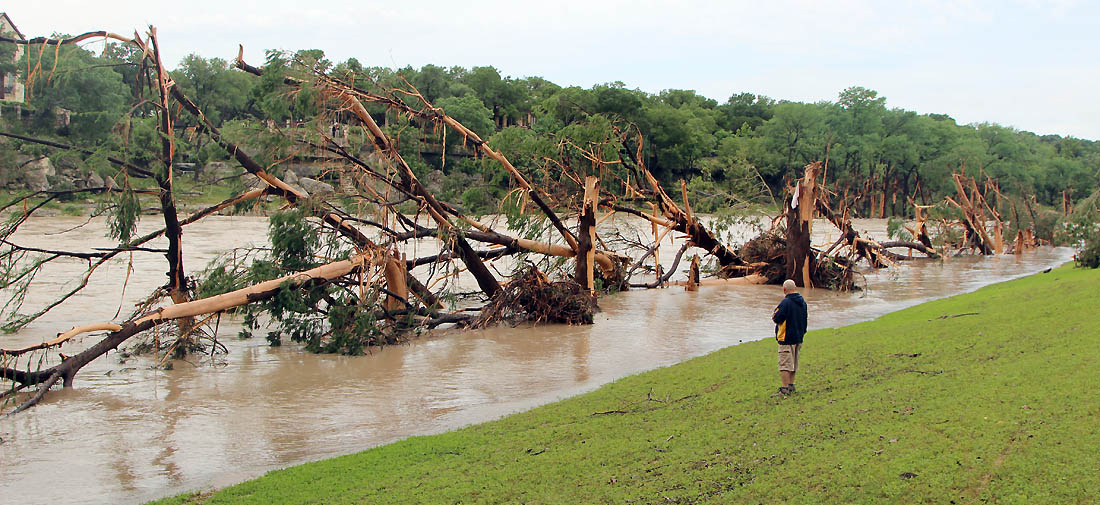Poem Three
nadIsamaud`saMvaad: È
(Conversation
between river and ocean)

saagar ]vaaca
samaUlaSaaKana\ pSyaaima inahtana\ kaiyanaao
d`umaana\ È
Sandhi Dissolution:
1) kaiyanaao d`umaana\ Ä kaiyana: + d`umaana\ È
1) kaiyanaao d`umaana\ Ä kaiyana: + d`umaana\ È
2) yauYmaaiBairh Ä
yauYmaaiBa: + [h È
3) pUNaa-iBana-Vst~ Ä
pUNaa-iBa: + naV: + t~ È
Meanings: samaUlaSaaKana\ Ä along with the roots and branches, inahtana\ Ä destroyed, kaiyana: Ä having trunks, d`umaana\ Ä trees, pUNaa-iBa: Ä flooded,
vaotsama\ Ä cane.
Translation:
The ocean said - O rivers, here I see the trees having trunks
The ocean said - O rivers, here I see the trees having trunks
destroyed along with the roots and branches by you who
are flooded.
There (I do not see) the cane.
AkayaScaalpsaarSca vaotsa: kUlajaSca va: È
Ava&yaa vaa naanaIt: ikM ca vaa tona va: Ìtma\ ÈÈ 2 ÈÈ


Sandhi Dissolution:
1) AkayaScaalpsaarSca ÄAkaya: + ca + Alpsaar: + ca È
1) AkayaScaalpsaarSca ÄAkaya: + ca + Alpsaar: + ca È
2) kUlajaSca Ä kUlaja: + ca È
3) naanaIt:Ä na + AanaIt: È
Meanings:Akaya: Ä has no (solid) trunk, Alpsaar: Ä light, kUlaja: Ä born on your bank,
vaotsa: Ä cane, Ava&yaa Ä due to disrespect.
Translation: Did you not bring cane, born on your
bank, which is
light and has no (solid) trunk, due to disrespect or has
something been
done (good) to you by it?
nadI ]vaaca
itYz\yan%yaoto yaqaasqaanaM nagaa *yaokinakotnaa: È
to %yajaint tt: sqaanaM p`aitlaaomyaanna vaotsa: ÈÈ 3 ÈÈ


Sandhi Dissolution: 1) itYz\yan%yaoto
Ä itYzint + eto È
2) *yaokinakotnaa: Ä ih + ekinakotnaa: È
3) p`aitlaaomyaanna Ä
p`aitlaaomyaat\ + na È
Meanings: itYzint Ä stand, yaqaasqaanaM Ä in their
respective places,
nagaa: Ä trees, ekinakotnaa: Ä living in one places,
p`aitlaaomyaat\ Ä due to opposition.
Translation:
The river said - These trees living in one place indeed
stand in their
respective place. Then due to opposition (to the flood),
they leave
(their) place; (but) not the cane.
vaotsaao vaogamaayaatM dRYT\vaa namait naapro È
sairWogao vyaitËanto sqaanamaasaaV itYzit ÈÈ 4 ÈÈ
Sandhi Dissolution:
1) vaogamaayaatM Ä vaogama\ + Aayaatma\ È
1) vaogamaayaatM Ä vaogama\ + Aayaatma\ È
2) naapro Ä na + Apro È
3) sqaanamaasaaV Ä sqaanama\ + AasaaV È
Meanings: namait Ä bends, inahtana\ Ä destroyed,
kaiyana: Ä having trunks, d`umaana\ Ä trees,
pUNaa-iBa: Ä flooded, vaotsama\ Ä cane.
Translation:
The cane bends seeing the flood coming (towards it). The
others do
not bend. When flood of the river subsides, acquiring
(own) place
(cane) stays.
kala&: samayaSca sada vaSyaSca naaowt: È
AnaulaaomastqaastbQastona naaByaoit vaotsa: ÈÈ 5 ÈÈ
Sandhi Dissolution:
1) samayaSca Ä samaya: + ca È 2) vaSyaSca Ä vaSya: + ca È
3) naaowt:Ä na + ]wt: È 4) naaByaoit Ä na + AByaoit È
5) Anaulaaomastqaa Ä
Anaulaaoma: + tqaa + AstbQa: + tona
È
Meanings:vaSya: Ä humble, na ]wt: Ä not proud,
Anaulaaoma: Ä favorable, AstbQa: Ä moveable,
na AByaoit Ä doesn't come.
Translation:
The cane knows the time and situation, humble, not proud,
favorable
and moveable. Due to that, (it) doesn't come (with
flood).
BaIYma ]vaaca
evamaova yada ivaWana\ manyato|itbalaM irpuma\ È
saMEayaod\ vaOtsaIM vaRi<amaott\ p`&analaxaNama\ ÈÈ 6 ÈÈ
Sandhi Dissolution:
1) BaIYma ]vaaca Ä BaIYma: + ]vaaca È 2) evamaova Ä evama\ + eva È
3) manyato|itbalaM Ä manyato + Aitbalama\ È 4) vaRi<amaott\ Ä
vaRi<ama\ + ett\ È
Meanings:Aitbalama\ Ä more powerful,
saMEayaot\ Ä should adopt,
p`&analaxaNama\ Ä sign of intelligence.
Translation:
Bhishma said - In the same way, when a wise man considers
his
enemy to be more powerful, he should adopt this vaOtsaI vaRi<a (course of
behavior like the cane). This is the sign of
intelligence.
*************





Post a Comment